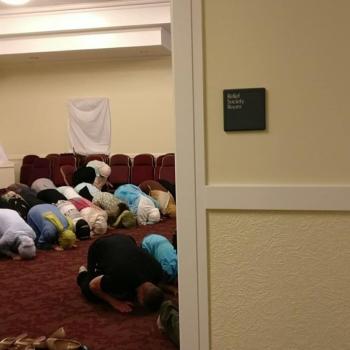
One of the earliest mystics in Islam, Rabi‘a was born near Basra, in Iraq. (The area has changed a bit since her day.) She died in AD 801 on the Mount of Olives, overlooking Jerusalem.
I share some further notes from Margaret Smith, Muslim Women Mystics: The Life and Work of Rābiʿa and Other Women Mystics in Islam (Oxford: Oneworld, 2001). These are from pages 29-52:
It is said that Rābiʿa al-‘Adawiyya or, as she is sometimes also known because of her birthplace, Rābiʿa al-Baṣriyya received many offers of marriage, but that she rejected all of them. She felt that she could pursue her spiritual path only via a celibate life. So, very much like a Christian nun, “Rábiʿa espoused a heavenly bridegroom and turned her back on earthly marriage even with one of her own intimates and companions on the Way” (32)
Margaret Smith passes on a story about how Rābiʿa once visited an ascetic woman named Hayyúna, who used to pray “O God, I would that the day were night that I might enjoy Thy proximity”:
In the middle of the night sleep overcame Rábiʿa, and Hayyúna rose and came to her and kicked her with her foot, and said, “Rise up, the Bridegroom of the truly guided ones has come. The adornments of the brides of night are revealed by the light of the night-prayers.” This anecdote is remarkable in that it is the only passage I have met with which makes a reference to the spiritual marriage of lover and Beloved, in these terms, applied to Ṣúfís, and it appears also as if there might be a reference to the parable of the Ten Virgins. (48-49)
She lived, generally, as an ascetic, deliberately choosing poverty and self-denial even when, over and over again, her friends offered her help to escape hardship and discomfort. After her manumission as a slave, she lived for a while in a cave or cell in the Mesopotamian desert. And, even when she returned to Baṣra, she lived a life apart from the world except for a stream of visits from disciples and admirers.
Her recorded prayers are striking. As Margaret Smith remarks, they show that, for her, prayer was “loving converse” or communion with the Lord, whom she regarded as a Friend. It was not supplication, whether for her earthly friends or on her own behalf.
It is told of her, for instance, that she would climb to the roof of her house at night and pray:
O my Lord, the stars are shining and the eyes of men are closed, and kings have shut their doors and every lover is alone with his beloved, and here am I alone with Thee. (47)
Here are two more of her prayers:
O my Lord, whatever share of this world Thou dost bestow on me, bestow it on Thine enemies, and whatever share of the next world Thou dost give me, give it to Thy friends. Thou art enough for me. (49-50)
O my Lord, if I worship Thee from fear of Hell, burn me in Hell, and if I worship Thee from hope of Paradise, exclude me thence, but if I worship Thee for Thine own sake then withhold not from me Thine Eternal Beauty. (50)
The great early Sufi mystic Ḥasan of Baṣra (AD 642-728) is reported to have said of her that
I passed one whole night and day with Rábiʿa speaking of the Way and the Truth, and it never passed through my mind that I was a man nor did it occur to her that she was a woman, and at the end when I looked at her, I saw myself a bankrupt [i.e., spiritually worth nothing], and Rábiʿa as truly sincere. (33)
However, the fact that they were of different genders might have occurred to Ḥasan at least at some point, because he is also reputed to have proposed marriage to Rābiʿa. Which she, of course, refused. (Which is too bad, because they would have become a real power couple.) Is this true? I doubt it. Rābiʿa’s birthyear is variously given as AD 714, AD 717, or AD 718. (She died in AD 801.) Which means that she would have been at most fourteen years old, and possibly as young as ten, when Ḥasan died.
But the stories about her, however, much or little they reflect of her actual biography, say something rather surprising about those devout Muslims who treasured them:
Rābiʿa al-‘Adawiyya associated on equal terms with the Ṣúfí leaders of her day, and her biographers, despite the Oriental preference for the male sex and belief in its essential superiority, are prepared to grant to Rābiʿa a position of equality with, even of pre-eminence above her contemporaries, including those who were accepted as leaders of thought and revered teachers of the Ṣúfí doctrine. (37)












